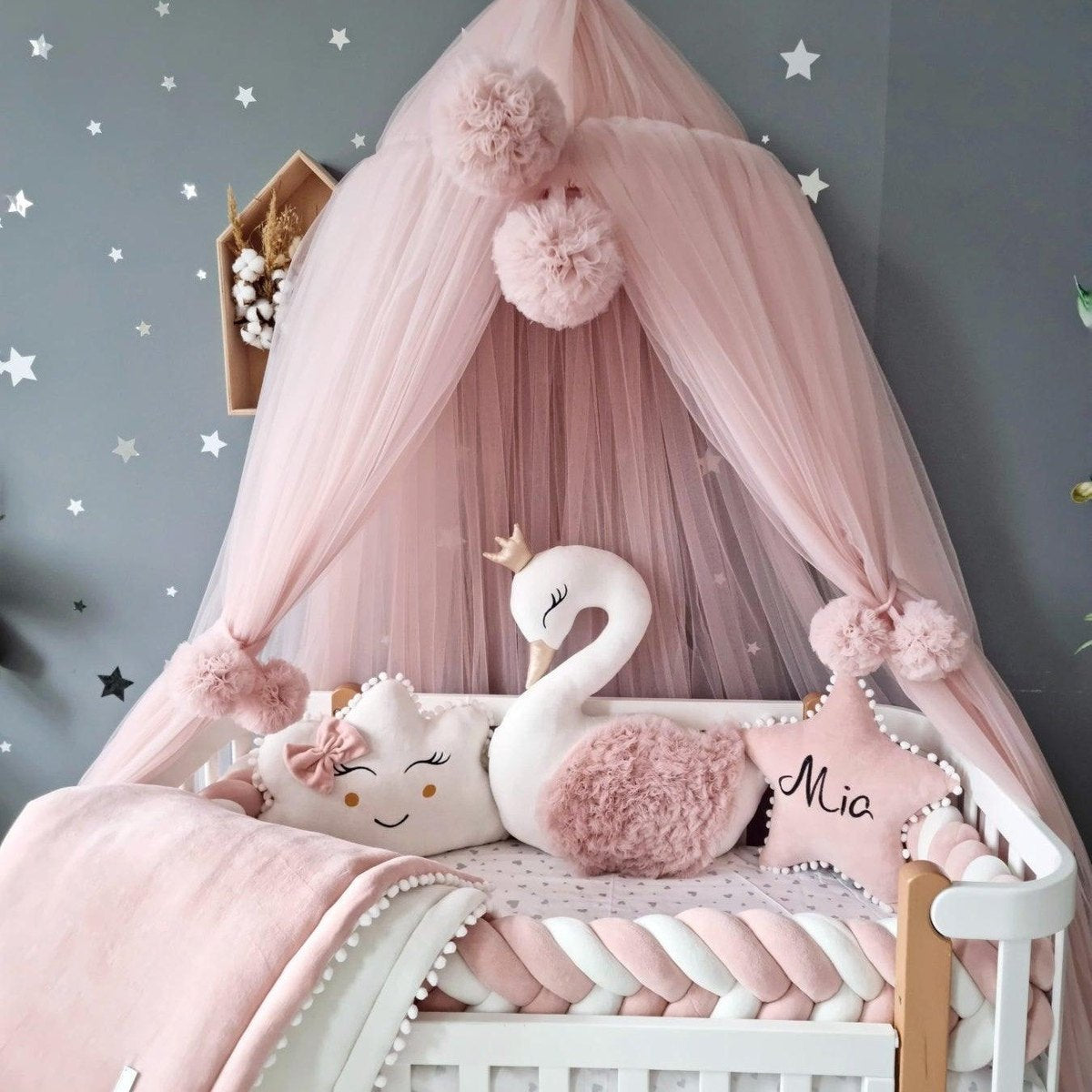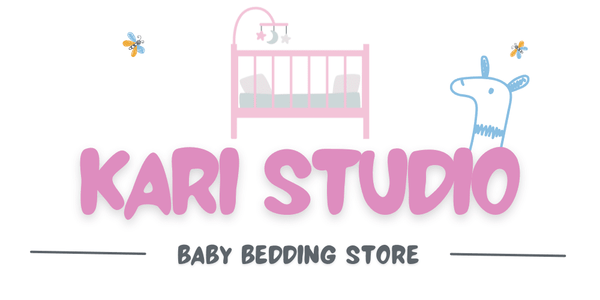Das Aufstellen eines Kinderbetts mag einfach erscheinen, ist aber tatsächlich einer der wichtigsten Schritte für die Sicherheit Ihres Babys. Experten haben festgestellt , dass Kinderbetten mit falschem Lattenabstand jedes Jahr für Hunderte von Verletzungen bei Säuglingen verantwortlich sind . Die meisten Eltern denken, es reiche aus, die schönste Kinderzimmerecke auszusuchen und weiche Decken hinzuzufügen, aber die wahre Sicherheit hängt von der präzisen Platzierung, dem genauen Messen und regelmäßigen Kontrollen ab, die man nie für wichtig hielte, bis man merkt, wie schnell kleine Details den größten Unterschied machen können.
Inhaltsverzeichnis
- Schritt 1: Wählen Sie den richtigen Standort für das Kinderbett
- Schritt 2: Bauen Sie das Kinderbett gemäß den Anweisungen zusammen
- Schritt 3: Sicherstellen, dass die Sicherheitsstandards eingehalten werden
- Schritt 4: Bettzeug und Schlafumgebung einrichten
- Schritt 5: Stabilität und Sicherheitsfunktionen testen
- Schritt 6: Kinderzimmereinrichtung und -dekoration abschließen
Kurze Zusammenfassung
| Kernpunkt | Erläuterung |
|---|---|
| 1. Stellen Sie das Kinderbett fern von Gefahren auf | Stellen Sie das Kinderbett mindestens 60 cm von Fenstern, Kabeln und Heizungsöffnungen entfernt auf, um die Sicherheit und den Komfort Ihres Babys zu gewährleisten. |
| 2. Befolgen Sie die Montageanleitung sorgfältig | Lesen und befolgen Sie die Anweisungen des Herstellers, um sicherzustellen, dass das Kinderbett sicher und korrekt zusammengebaut ist. |
| 3. Halten Sie den richtigen Lamellenabstand ein | Stellen Sie sicher, dass die Latten nicht mehr als 6 cm voneinander entfernt sind, um ein Einklemmen des Kopfes zu verhindern und die Sicherheit Ihres Babys im Schlaf zu gewährleisten. |
| 4. Verwenden Sie aus Sicherheitsgründen nur minimale Einstreu | Beziehen Sie die Matratze mit einem Spannbettlaken. Vermeiden Sie Kissen oder Decken und entscheiden Sie sich stattdessen für einen Schlafsack, um das Erstickungsrisiko zu verringern. |
| 5. Führen Sie regelmäßige Sicherheitsinspektionen durch | Überprüfen Sie das Kinderbett regelmäßig auf Abnutzung oder Beschädigungen und stellen Sie sicher, dass alle Komponenten sicher sind, um eine sichere Schlafumgebung zu gewährleisten. |
Schritt 1: Wählen Sie den richtigen Standort für das Kinderbett
Bei der Wahl des perfekten Standorts für das Kinderbett geht es um mehr als nur darum, einen ästhetisch ansprechenden Platz im Kinderzimmer zu finden. Es geht darum, eine sichere, komfortable Umgebung zu schaffen, die das Wohlbefinden Ihres Babys fördert und einen gesunden Schlafrhythmus unterstützt. Sicherheit und Zugänglichkeit sind Ihre wichtigsten Kriterien bei der Wahl des idealen Kinderbetts.
Stellen Sie das Kinderbett zunächst so auf, dass es nicht in der Nähe potenzieller Gefahrenquellen steht. Unser umfassender Leitfaden zur Kinderbettauswahl empfiehlt, das Bett mindestens 60 cm von Fenstern, Vorhängen, Wandbehängen, Steckdosen und Heizungsöffnungen entfernt aufzustellen. Diese strategische Positionierung verhindert zahlreiche Risiken wie Zugluft, direkte Sonneneinstrahlung, mögliche Strangulation durch das Kabel und Temperaturschwankungen, die den Schlaf Ihres Babys stören oder seine Sicherheit gefährden könnten.
Berücksichtigen Sie die Raumaufteilung und den einfachen Zugang zum Kinderbett. Eltern benötigen schnellen und ungehinderten Zugang zum Babybett beim nächtlichen Füttern, Windeln wechseln und für beruhigende Momente. Stellen Sie das Kinderbett so auf, dass Sie Ihr Baby erreichen können, ohne um Möbel herumlaufen oder längere Strecken zurücklegen zu müssen. Sorgen Sie dafür, dass freie Wege um das Kinderbett herum bestehen und Sie es so platzieren können, dass Sie schnell auf die Bedürfnisse Ihres Babys reagieren können.
Die Temperaturregulierung ist ein weiterer wichtiger Faktor bei der Platzierung des Kinderbetts. Vermeiden Sie es, das Bett in der Nähe von Heizkörpern, Klimaanlagen oder direkter Sonneneinstrahlung aufzustellen, da dies zu unangenehmen Temperaturschwankungen führen kann. Achten Sie auf eine konstante Raumtemperatur zwischen 20 und 22 Grad Celsius, die von Kinderärzten als optimal für den Schlaf Ihres Babys empfohlen wird. Sorgen Sie für eine stabile Umgebung , in der sich Ihr Baby sicher fühlt und ungestörter Schlaf gefördert wird.
Berücksichtigen Sie außerdem Geräuschpegel und visuelle Reize. Stellen Sie das Kinderbett zwar an einem geeigneten Ort auf, vermeiden Sie jedoch die direkte Nähe zu lauten Bereichen wie Fluren, Fernsehzimmern oder Außenwänden in der Nähe von Straßenlärm. Wählen Sie eine relativ ruhige Ecke, die ein Gefühl von Sicherheit vermittelt und mögliche Schlafstörungen minimiert. Ziel ist es, einen ruhigen Schlafplatz zu schaffen, der die Entwicklungsbedürfnisse Ihres Babys unterstützt und einen erholsamen, sicheren Schlaf gewährleistet.
Schritt 2: Bauen Sie das Kinderbett gemäß den Anweisungen zusammen
Der Aufbau eines Kinderbetts erfordert Geduld, Präzision und Liebe zum Detail. Der richtige Aufbau ist entscheidend für die Sicherheit Ihres Babys und verwandelt aus vielen Einzelteilen eine sichere Schlafumgebung. Schaffen Sie vor Beginn einen geräumigen, gut beleuchteten Bereich und legen Sie alle notwendigen Werkzeuge bereit, um den Aufbau zu optimieren.
Lesen Sie vor Beginn die Anweisungen des Herstellers vollständig durch.
Erfahren Sie mehr über bewährte Vorgehensweisen bei der Montage von Kinderbetten, um sicherzustellen, dass Sie jeden Schritt verstehen. Den meisten Kinderbetten liegt eine ausführliche Anleitung mit den spezifischen Montageanforderungen bei. Legen Sie alle Komponenten bereit und überprüfen Sie, ob alle aufgeführten Teile vorhanden sind. Ersetzen oder überspringen Sie keine Beschläge , da jede Schraube, jeder Bolzen und jede Halterung eine entscheidende Rolle für die strukturelle Integrität spielt.
Beginnen Sie mit dem Aufbau, indem Sie eine stabile Basis schaffen. Bei den meisten Kinderbetten müssen Sie zuerst den Rahmen zusammenbauen und sicherstellen, dass alle Verbindungen fest und perfekt ausgerichtet sind. Verwenden Sie das vom Hersteller bereitgestellte Werkzeug anstelle Ihres eigenen Werkzeugkastens, um die richtige Passform und Spannung zu gewährleisten. Achten Sie besonders auf die Eckverbindungen, die erhebliches Gewicht tragen und für grundlegende Stabilität sorgen. Stellen Sie sicher, dass jedes Teil sicher einrastet und nicht wackelt oder sich übermäßig bewegt.
Beim Zusammenbau ist das Ausmessen entscheidend. Achten Sie auf die genauen Abstände zwischen den Latten und stellen Sie sicher, dass keine Lücken größer als 60 mm sind, da dies für Kleinkinder eine Einklemmgefahr darstellen könnte. Testen Sie den Matratzenstützmechanismus mehrmals und vergewissern Sie sich, dass er in verschiedenen Höheneinstellungen fest einrastet. Einige moderne Kinderbetten bieten verstellbare Matratzenhöhen, um sich an Ihr wachsendes Baby anzupassen. Daher ist es wichtig, diesen Mechanismus zu verstehen.
Führen Sie nach Abschluss der Montage eine umfassende Sicherheitsprüfung durch. Schütteln Sie das Kinderbett vorsichtig, um die Stabilität zu testen.
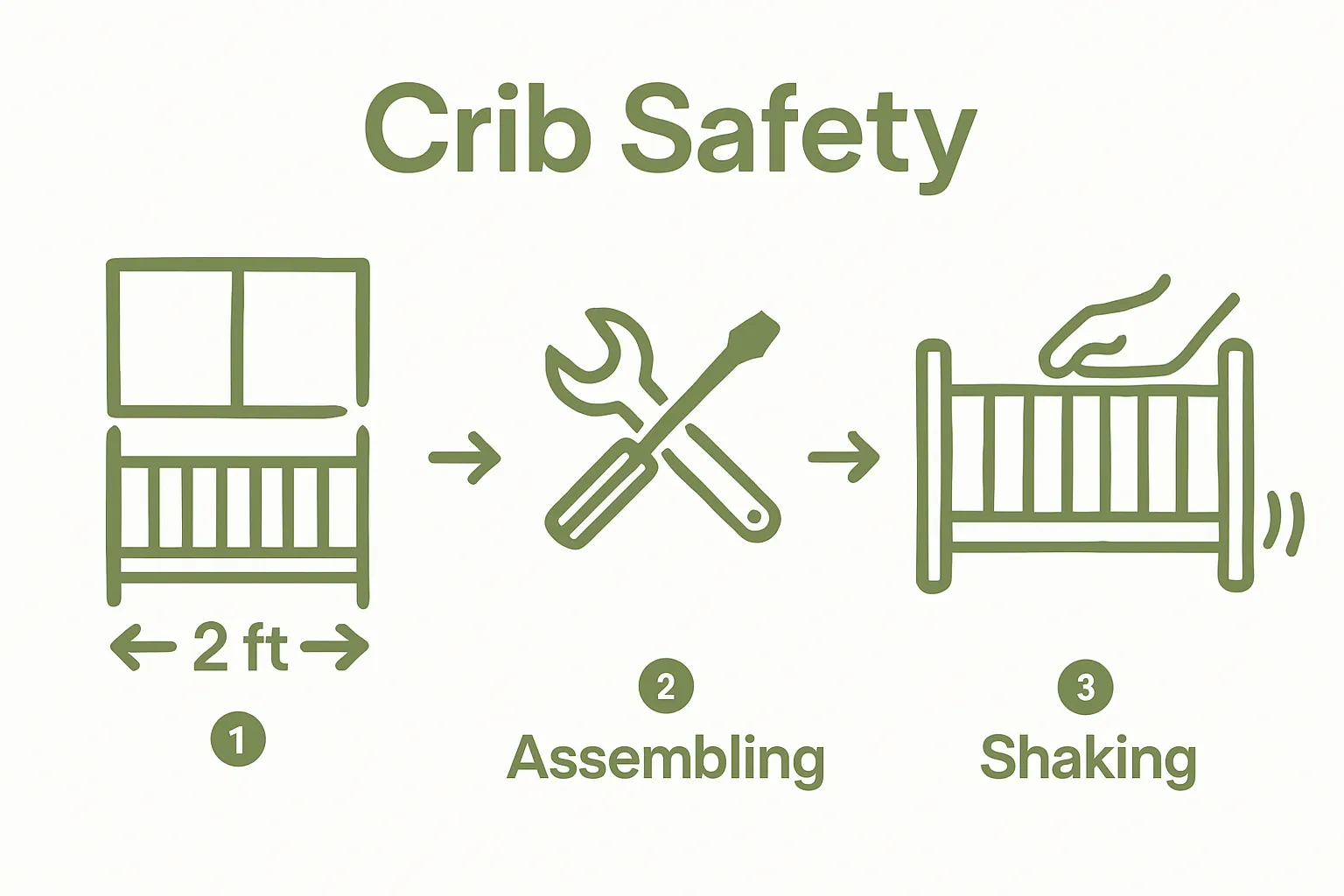 Stellen Sie sicher, dass keine scharfen Kanten, hervorstehenden Schrauben oder Quetschstellen vorhanden sind. Überprüfen Sie alle Anschlüsse und stellen Sie sicher, dass das Kinderbett den aktuellen Sicherheitsstandards entspricht. Bei Zweifeln an der Montage wenden Sie sich an einen Fachmann oder direkt an den Hersteller. Ein korrekt montiertes Kinderbett ist die erste Schutzmaßnahme für eine sichere Schlafumgebung Ihres Babys.
Stellen Sie sicher, dass keine scharfen Kanten, hervorstehenden Schrauben oder Quetschstellen vorhanden sind. Überprüfen Sie alle Anschlüsse und stellen Sie sicher, dass das Kinderbett den aktuellen Sicherheitsstandards entspricht. Bei Zweifeln an der Montage wenden Sie sich an einen Fachmann oder direkt an den Hersteller. Ein korrekt montiertes Kinderbett ist die erste Schutzmaßnahme für eine sichere Schlafumgebung Ihres Babys.
Schritt 3: Sicherstellen, dass die Sicherheitsstandards eingehalten werden
Sicherzustellen, dass das Kinderbett Ihres Babys den aktuellen Sicherheitsstandards entspricht, ist nicht nur eine Empfehlung – es ist eine wichtige Verantwortung zum Schutz Ihres Kindes. Sicherheitsstandards entwickeln sich ständig weiter und spiegeln die laufende Forschung und das Verständnis für den Schutz von Säuglingen wider. Erfahren Sie mehr über umfassende Sicherheitsrichtlinien für Kinderbetten, um über die neuesten Empfehlungen informiert zu bleiben.
Überprüfen Sie zunächst das Herstellungsdatum und die Konformitätsbescheinigung des Kinderbetts. Kinderbetten, die nach dem 28. Juni 2011 hergestellt wurden, müssen den strengen Sicherheitsvorschriften der US-amerikanischen Verbraucherschutzbehörde (Consumer Product Safety Commission) entsprechen. Achten Sie auf dauerhafte Etiketten, die die Einhaltung der aktuellen Bundessicherheitsstandards belegen. Diese befinden sich in der Regel am Rahmen oder an der Unterseite des Kinderbetts. Diese Etiketten sind Ihr erster Hinweis darauf, dass das Kinderbett strenge Tests hinsichtlich struktureller Integrität, Materialsicherheit und Gefahrenabwehr bestanden hat.
Überprüfen Sie die technischen Eigenschaften des Kinderbetts sorgfältig. Der Abstand zwischen den Latten sollte maximal 60 mm betragen, um ein Einklemmen des Kopfes des Kindes zu verhindern. Achten Sie darauf, dass die Eckpfosten nicht mehr als 3 mm über die Seitenteile hinausragen, da sich sonst Kleidung verfangen und Strangulationsgefahr besteht. Die Matratze sollte eng anliegen, mit maximal zwei Fingerbreit Abstand zwischen Matratzenrand und Kinderbettwand – so vermeiden Sie Erstickungsgefahr.
Achten Sie besonders auf die Beschläge und Strukturkomponenten. Stellen Sie sicher, dass alle Verbindungen fest und sicher sind und keine hervorstehenden Schrauben oder scharfen Kanten aufweisen. Das Kinderbett sollte keine dekorativen Aussparungen im Kopf- oder Fußteil haben, in denen der Kopf oder die Gliedmaßen des Babys eingeklemmt werden könnten. Vermeiden Sie Kinderbetten mit herunterklappbaren Seitengittern, da diese aufgrund erheblicher Sicherheitsbedenken verboten wurden. Überprüfen Sie das Kinderbett regelmäßig auf Anzeichen von Verschleiß, Beschädigungen oder gelösten Komponenten, die die strukturelle Integrität beeinträchtigen könnten.
Denken Sie daran, dass die Einhaltung von Sicherheitsstandards ein fortlaufender Prozess ist. Überprüfen Sie das Kinderbett monatlich auf mögliche Probleme, die sich im Laufe der Zeit entwickelt haben könnten. Ziehen Sie Schrauben fest, untersuchen Sie das Holz auf Risse oder Splitter und stellen Sie sicher, dass alle beweglichen Teile reibungslos funktionieren. Ihre Wachsamkeit ist das wichtigste Sicherheitsmerkmal und verwandelt ein einfaches Möbelstück in einen sicheren Rückzugsort für Ihr liebstes Familienmitglied.
Schritt 4: Bettzeug und Schlafumgebung einrichten
Eine sichere und komfortable Schlafumgebung zu schaffen, bedeutet weit mehr als nur ein Laken auf die Matratze zu legen. Minimalismus ist der Schlüssel zum Schlafen von Kleinkindern, wobei Sicherheit Vorrang vor ästhetischen Vorlieben hat. Entdecken Sie unseren Leitfaden zu modernen Designstandards für Kinderzimmer, um die entscheidende Balance zwischen Komfort und Schutz zu verstehen.
Beginnen Sie mit der Matratze, die eng in den Rahmen des Kinderbetts passen sollte. Wählen Sie eine feste, flache Unterlage, die speziell für den Schlaf Ihres Babys entwickelt wurde – ohne zusätzliche Polster, Steppdecken oder weiche Materialien, die die Atemfreiheit einschränken könnten. Der Matratzenbezug sollte wasserdicht und eng anliegend sein , ohne überschüssigen Stoff, der sich zusammenballen oder die Atmung behindern könnte. Investieren Sie in zwei bis drei Spannbettlaken, die speziell auf die Größe Ihrer Kinderbettmatratze zugeschnitten sind und so für einen perfekten, sicheren Sitz sorgen.
Laut Empfehlungen der American Academy of Pediatrics sollten Säuglinge in einer möglichst leeren Umgebung schlafen. Das bedeutet, dass im Kinderbett absolut keine Kissen, Decken, Nestchen oder Kuscheltiere sein sollten. Verwenden Sie stattdessen für jüngere Säuglinge einen tragbaren Schlafsack oder ein Wickeltuch, das für Wärme sorgt, ohne die Risiken loser Bettwäsche. Diese spezielle Kleidung sorgt für Komfort, lässt Ihrem Baby freie Atemwege und verringert das Risiko einer Überhitzung.
Die Temperaturregulierung ist entscheidend für eine optimale Schlafumgebung. Halten Sie die Raumtemperatur zwischen 20 und 22 Grad Celsius und tragen Sie leichte, atmungsaktive Kleidung für Ihr Baby. Ziehen Sie Ihrem Baby eine Schicht mehr an, als Sie selbst gerne tragen würden , normalerweise einen Strampler und einen leichten Schlafsack. Vermeiden Sie zu warme Kleidung, da Säuglinge schnell überhitzen können, was potenzielle Gesundheitsrisiken erhöht.
Führen Sie abschließend einen umfassenden Sicherheitscheck der gesamten Schlafumgebung durch. Stellen Sie sicher, dass sich keine Kabel, Vorhänge oder Dekorationsgegenstände in Reichweite des Kinderbetts befinden. Stellen Sie das Kinderbett nicht in der Nähe von Fenstern, Heizungen und Steckdosen auf. Ihre abschließende Überprüfung umfasst eine sorgfältige visuelle und physische Inspektion – ziehen Sie vorsichtig an den Laken, um ihren sicheren Sitz zu gewährleisten, überprüfen Sie die Ausrichtung der Matratze und stellen Sie sicher, dass in der unmittelbaren Schlafumgebung Ihres Babys keine potenziellen Gefahren bestehen.
Schritt 5: Stabilität und Sicherheitsfunktionen testen
Der letzte Schritt beim Aufbau des Kinderbetts umfasst eine umfassende Sicherheitsbewertung, die den sorgfältigen Aufbau in eine wirklich sichere Schlafumgebung verwandelt. Systematische Tests sind Ihre letzte Verteidigungslinie gegen potenzielle Gefahren für Ihr Baby. Informieren Sie sich über unseren detaillierten Sicherheitsüberprüfungsprozess, um sicherzustellen, dass bei dieser kritischen Inspektion nichts übersehen wird.
Beginnen Sie mit einem gründlichen Stabilitätstest. Üben Sie gemäß den Sicherheitsrichtlinien für Verbraucher sanften, aber festen Druck auf jede Ecke und Seite des Kinderbetts aus und achten Sie auf unerwartete Bewegungen oder Wackeln. Robuste Kinderbetten sollten absolut starr sein und nur minimal nachgeben. Schaukeln Sie das Bett leicht, um die Bewegungen des Säuglings zu simulieren, und vergewissern Sie sich, dass alle Gelenke, Schrauben und Verbindungspunkte fest und sicher sind. Achten Sie besonders auf den Matratzenstützmechanismus und stellen Sie sicher, dass er in verschiedenen Höheneinstellungen fest einrastet, ohne unerwartet nachzugeben.
Führen Sie anschließend eine detaillierte Überprüfung der Hardware und der Struktur durch. Überprüfen Sie jede Schraube, jeden Bolzen und jeden Verbindungspunkt auf korrekte Spannung und Ausrichtung. Achten Sie auf mögliche Quetschstellen oder scharfe Kanten , die für neugierige Babys eine Gefahr darstellen könnten. Streichen Sie vorsichtig mit den Händen über alle Oberflächen und tasten Sie nach rauen Stellen, Splittern oder hervorstehenden Teilen, an denen sich Kleidung oder Haut verfangen könnten. Stellen Sie sicher, dass die Matratze genau passt und nicht mehr als zwei Fingerbreit Platz zwischen Matratzenrand und Bettseiten bleibt – ein wichtiges Maß, um mögliche Einklemmgefahren zu vermeiden.
Vervollständigen Sie Ihre Sicherheitsbewertung, indem Sie Interaktionen mit Kleinkindern simulieren. Testen Sie die Stabilität der Geländer durch kontrollierten Druck und stellen Sie sicher, dass sie sich nicht versehentlich lösen oder absenken können. Überprüfen Sie die Zuverlässigkeit aller beweglichen Teile, wie z. B. verstellbare Matratzenhöhen oder Umbaumechanismen. Untersuchen Sie die allgemeine strukturelle Integrität und achten Sie auf Anzeichen von Schwächen oder potenziellen Fehlerquellen, die bei regelmäßiger Nutzung auftreten können.
Ihre abschließende Überprüfung umfasst einen umfassenden Rundgang. Stellen Sie sich Ihr Baby im Raum vor und identifizieren Sie alle potenziellen Risiken aus verschiedenen Blickwinkeln. Machen Sie gegebenenfalls Fotos, um Ihre gründliche Inspektion visuell zu dokumentieren. Das Ziel ist absolute Sicherheit – ein Kinderbett, das nicht nur sicher aussieht, sondern Ihrem wertvollsten Familienmitglied auch einen echten Zufluchtsort bietet. Vertrauen Sie Ihrem Instinkt; wenn Ihnen auch nur ein bisschen etwas merkwürdig vorkommt, wenden Sie sich an einen Fachmann oder ziehen Sie einen kompletten Austausch des Kinderbetts in Erwägung.
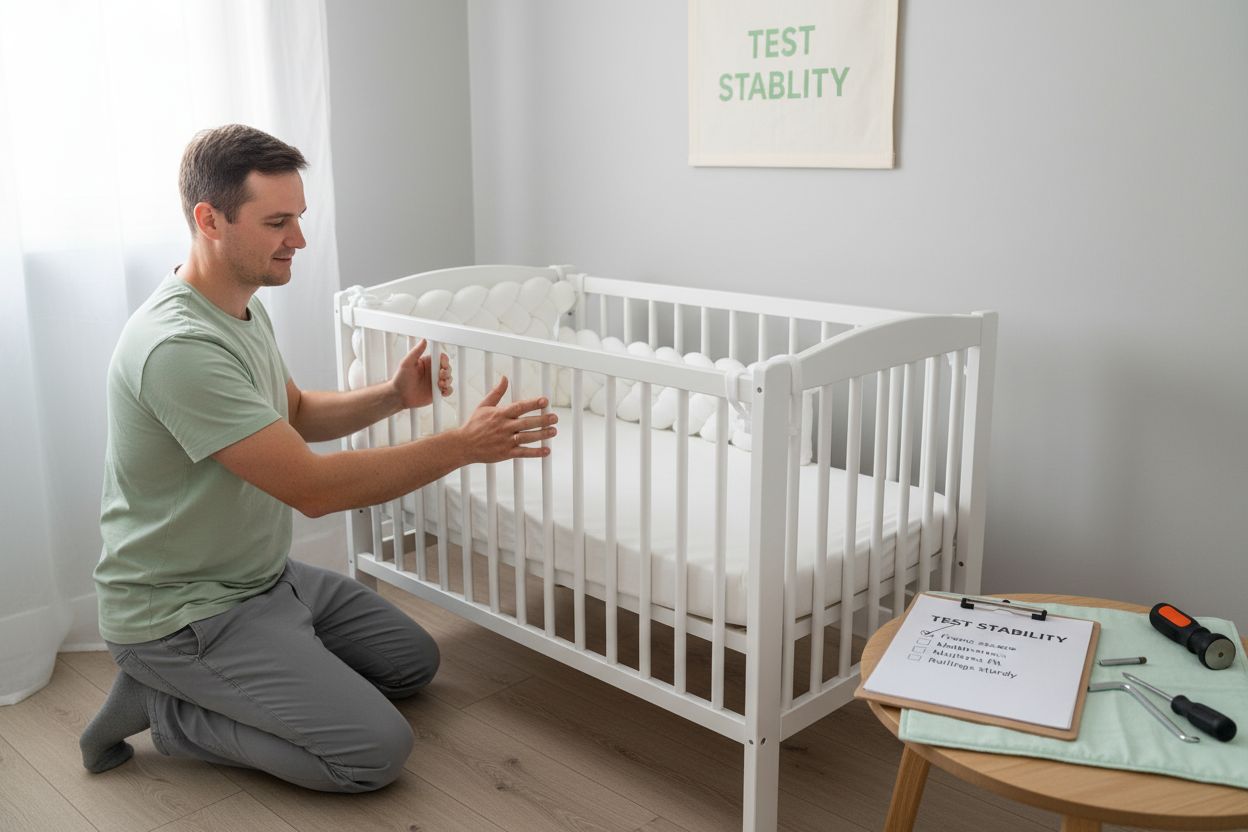
Schritt 6: Einrichtung und Dekoration des Kinderzimmers abschließen
Im letzten Schritt der Kinderzimmergestaltung verwandeln Sie einen funktionalen Raum in einen behaglichen Rückzugsort für Ihr Baby. Sicherheit und Einfachheit sollten Ihre Gestaltungsentscheidungen bestimmen und Ästhetik mit praktischen Aspekten in Einklang bringen. Entdecken Sie unsere Tipps zur Kinderzimmergestaltung und schaffen Sie eine harmonische Umgebung, die die Entwicklung Ihres Babys und die Bedürfnisse Ihrer Familie unterstützt.
Platzieren Sie Möbel strategisch, um freie Wege zu schaffen und die Sicherheit zu maximieren. Das Kinderbett sollte im Mittelpunkt stehen und nicht in der Nähe von Fenstern, Steckdosen und potenziellen Gefahrenquellen platziert werden. Halten Sie mindestens 60 cm Abstand um das Kinderbett, um ungehinderten Zugang während der nächtlichen Pflege zu gewährleisten. Achten Sie auf die Beleuchtung des Zimmers und wählen Sie eine sanfte, einstellbare Beleuchtung, die zum Schlafen gedimmt und für Aktivitäten tagsüber heller eingestellt werden kann. Verdunkelungsvorhänge können helfen, das Licht zu regulieren und einen gesunden Schlaf zu fördern. Achten Sie jedoch darauf, dass sie sicher angebracht und außerhalb der Reichweite Ihres Babys sind.
Wählen Sie Dekorationselemente, die Ihr Baby stimulieren und beruhigen. Sanfte, neutrale Farben fördern die Ruhe und passen sich dem Wachstum Ihres Kindes an. Vermeiden Sie übermäßige Dekoration oder hängende Gegenstände in der Nähe des Kinderbetts. Wandbilder sollten sicher und in sicherer Entfernung angebracht werden , um mögliche Stürze zu vermeiden. Stellen Sie einen bequemen Stuhl zum Füttern und für die gemeinsame Zeit auf. Stellen Sie ihn so auf, dass Sie freie Sicht auf das Kinderbett haben und gleichzeitig einen sicheren Abstand zu möglichen Gefahren einhalten.
Abschließende Sicherheitschecks sind in dieser Phase entscheidend. Sichern Sie lose Kabel von Fensterdekorationen, stellen Sie sicher, dass Steckdosen abgedeckt sind, und prüfen Sie, ob alle Möbel stabil stehen und nicht umkippen können. Platzieren Sie ein Babyphone strategisch so, dass Sicht- und Audiokontakt gewährleistet ist, ohne zusätzliche Gefahren zu schaffen. Nehmen Sie sich einen Moment Zeit, um im Zimmer zu sitzen und den Raum aus der Perspektive Ihres Babys zu betrachten – so erkennen Sie potenzielle Risiken, die Sie bei der Ersteinrichtung möglicherweise übersehen haben.
Hier ist eine Checklistentabelle, die Eltern dabei hilft, alle wesentlichen Sicherheitsanforderungen für Kinderbetten, die in der Aufbauanleitung erwähnt werden, systematisch zu überprüfen.
| Sicherheitscheck | Was zu bestätigen ist | Frequenz |
|---|---|---|
| Platzierung des Kinderbetts | Mindestens zwei Fuß von Fenstern, Kabeln und Lüftungsöffnungen entfernt | Anfänglich und fortlaufend |
| Lamellenabstand | Nicht mehr als 2,375 Zoll zwischen den Lamellen | Ersteinrichtung |
| Matratzenpassform | Nicht mehr als zwei Finger zwischen Matratze und Kinderbett | Anfänglich und monatlich |
| Matratzentyp | Fest und flach, für die Verwendung mit Kleinkindern konzipiert | Ersteinrichtung |
| Bettzeug | Nur Spannbettlaken; keine Kissen, Decken oder Spielsachen | Jeder Einsatz |
| Hardware-Integrität | Alle Schrauben, Bolzen und Verbindungen sind fest und stabil | Monatlich |
| Eckpfosten/Kanten | Pfosten ragen nicht über die Paneele hinaus; keine scharfen Kanten | Anfänglich und monatlich |
| Temperatur | Die Raumtemperatur wird zwischen 20 und 22 °C gehalten. | Täglich |
Ihr Kinderzimmer ist mehr als nur ein Zimmer – es ist eine schützende Umgebung, die die frühe Entwicklung Ihres Kindes fördern und unterstützen soll.
Nachfolgend finden Sie eine Übersichtstabelle mit den wichtigsten Schritten zum sicheren Aufbau eines Kinderbetts. Diese Übersicht hilft Eltern, die einzelnen Schritte und ihr Hauptziel schnell zu verstehen.
| Schritt | Hauptaufgabe/Schwerpunkt | Ergebnis/Ergebnis |
|---|---|---|
| 1. Wählen Sie den Standort des Kinderbetts | Wählen Sie einen sicheren und zugänglichen Kindergartenplatz | Gefahren vermeiden, einfacher Zugang |
| 2. Kinderbett zusammenbauen | Befolgen Sie alle Anweisungen des Herstellers | Sicheres, richtig gebautes Kinderbett |
| 3. Sicherheitsstandards gewährleisten | Überprüfen Sie die Konformitätskennzeichnungen und physischen Sicherheitsmerkmale | Erfüllt die bundesstaatlichen Sicherheitsrichtlinien |
| 4. Bettwäsche anordnen | Spannbettlaken verwenden, keine losen Gegenstände, Temperatur regulieren | Minimiertes Erstickungs- und Überhitzungsrisiko |
| 5. Teststabilität | Struktur prüfen, Kinderbett schütteln, Hardware überprüfen | Bestätigt die Stabilität und deckt versteckte Mängel auf |
| 6. Kindergarten fertigstellen | Möbel organisieren, Zimmersicherheit prüfen, Dekoration anbringen | Bequemer, sicherer und beruhigender Kinderzimmerbereich |
Verwirklichen Sie Ihre Vision eines sicheren Kindergartens
Sie möchten, dass das Kinderbett Ihres Babys ein sicherer und behaglicher Ort ist, genau wie in unserer Sicherheitsanleitung für das Aufstellen von Kinderbetten beschrieben. Von der richtigen Platzierung und sicheren Montage bis hin zur Auswahl der optimalen Bettwäsche – alle Eltern möchten Gefahren vermeiden und durch jedes Detail für ein sicheres Gefühl sorgen. Doch die Suche nach Bettwäsche, die modernen Sicherheitsstandards entspricht, kann überwältigend sein.
Entdecken Sie, wie einfach es ist, diese Ziele bei Kari Studio zu erreichen. Unsere handgefertigten Nestchen-Sets für Jungenbetten sind auf Komfort und Sicherheit ausgelegt, sodass Sie für ein gutes Gefühl keine Kompromisse beim Stil eingehen müssen. Bevorzugen Sie einen individuelleren Look oder eine andere Farbe? Entdecken Sie unsere handgefertigten Nestchen-Polster für Jungenbetten sowie unsere Betthimmel und Vorhänge, um Ihr Kinderzimmer aufzuwerten und gleichzeitig die Sicherheit zu gewährleisten.
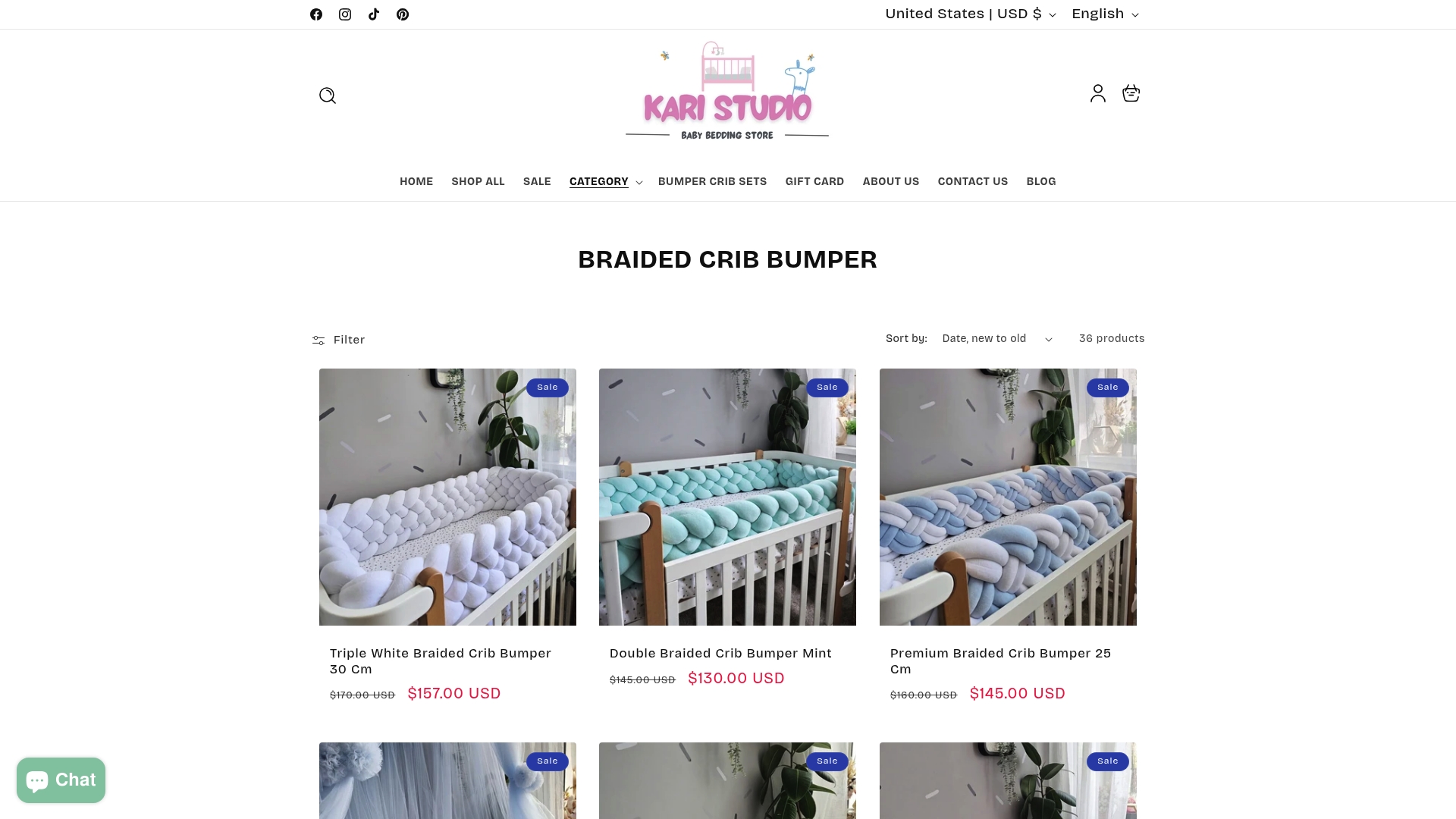
Warten Sie nicht bis zur letzten Minute, um das Kinderbett Ihres Babys zu sichern. Entdecken Sie jetzt die komplette Kollektion geflochtener Bettumrandungen von Kari Studio und finden Sie die sichersten und schönsten Bettwaren für Ihr Kinderzimmer. Kaufen Sie noch heute ein und schaffen Sie den perfekten Schlafplatz, von dem alle Eltern träumen.
Häufig gestellte Fragen
Was ist die sicherste Position für ein Kinderbett in einem Kinderzimmer?
Der sicherste Standort für ein Kinderbett ist mindestens 60 cm von Fenstern, Vorhängen, Wandbehängen, Steckdosen und Heizungsöffnungen entfernt, um Gefahren wie Zugluft, direkte Sonneneinstrahlung oder Strangulationsgefahr zu vermeiden.
Wie stelle ich sicher, dass mein Kinderbett aus Sicherheitsgründen richtig zusammengebaut ist?
Um eine ordnungsgemäße Montage zu gewährleisten, befolgen Sie die Anweisungen des Herstellers genau, überprüfen Sie, ob alle Komponenten enthalten sind, und kontrollieren Sie, ob alle Verbindungen sicher sind und keine Lücken oder scharfen Kanten vorhanden sind, die eine Gefahr darstellen könnten.
Welche Sicherheitsstandards gelten derzeit für Kinderbetten?
Kinderbetten, die nach dem 28. Juni 2011 hergestellt wurden, müssen den aktualisierten Sicherheitsvorschriften der US-amerikanischen Verbraucherschutzbehörde (Consumer Product Safety Commission) entsprechen. Achten Sie auf dauerhafte Etiketten am Rahmen des Kinderbetts, die die Einhaltung dieser Sicherheitsnormen belegen.
Wie kann ich eine sichere Schlafumgebung für mein Baby schaffen?
Um eine sichere Schlafumgebung zu schaffen, verwenden Sie eine feste Matratze mit guter Passform, vermeiden Sie lose Bettwaren wie Decken und Kissen und halten Sie die Raumtemperatur zwischen 20 und 22 Grad Celsius. Tragen Sie nur minimale Kleidung wie einen Strampler und einen Schlafsack.
Empfohlen
- Sichere und clevere Alternativen zu Babybett-Stoßstangen – KariStudio
- Sicherheit von Kinderbetthimmeln für Kleinkinder verstehen – KariStudio
- Sicherheit von Babybett-Stoßstangen: Was alle Eltern wissen sollten – KariStudio
- Sicherheit von Kinderbettmatratzen für Ihr Baby verstehen – KariStudio
- Sichere Kuscheltiere auswählen: 5 Schritte für Eltern 2025
- Sichere Lernumgebungen schaffen – Mats4U
